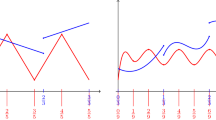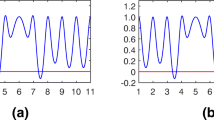Summary
This paper considers the theoretical development of finite dimensional bivariate blending function spaces and the problem of implementing the Ritz-Galerkin method in these approximation spaces. More specifically, the approximation theoretic methods of polynomial blending function interpolation and approximation developed in [2, 11–13] are extended to the general setting of L-splines, and these methods are then contrasted with familiar tensor product techniques in application of the Ritz-Galerkin method for approximately solving elliptic boundary value problems. The key to the application of blending function spaces in the Ritz-Galerkin method is the development of criteria which enable one to judiciously select from a nondenumerably infinite dimensional linear space of functions, certain finite dimensional subspaces which do not degrade the asymptotically high order approximation precision of the entire space. With these criteria for the selection of subspaces, we are able to derive a virtually unlimited number of new Ritz spaces which offer viable alternatives to the conventional tensor product piecewise polynomial spaces often employed. In fact, we shall see that tensor product spaces themselves are subspaces of blending function spaces; but these subspaces do not preserve the high order precision of the infinite dimensional parent space.
Considerable attention is devoted to the analysis of several specific finite dimensional blending function spaces, solution of the discretized problems, choice of bases, ordering of unknowns, and concrete numerical examples. In addition, we extend these notations to boundary value problems defined on planar regions with curved boundaries.
Similar content being viewed by others
References
Ahlberg, J. H., Nilson, E. N., Walsh, J. L.: The Theory of Splines and Their Applications. New York: Academic Press 1967
Birkhoff, G., Gordon, W. J.: The draftsman's and related equations. J. of Approximation Theory, (1967)
Birkhoff, G., Schultz, M., Varga, R. S.: Smooth Hermite interpolation for rectangles with applications to elliptic differential equations. Numer. Math.11, 232–256 (1968)
Caprili, M., Cella, A., Gheri, G.: Spline interpolation techniques for variational methods. Int. J. Solids Struct.6, 565–576 (1973)
Carlson, R., Hall, C. A.: Error bounds for bicubic spline interpolation. J. of Approximation Theory7, 41–47 (1973)
Cavendish, J. C., Gordon, W. J., Hall, C. A.: Ritz-Galerkin approximations in blending functions spaces. I. Approximation theoretic analysis. General Motors Research Report GMR-1572 (1974)
Cella, A.: Approximation Techniques in the Finite Element Method. To be published by Centre Internationelle des Sciences Mecaniques, Wien: Springer
Ciarlet, P., Schultz, M., Varga, R. S.: Numerical methods of high order accuracy for nonlinear boundary value problems. I. Numer. Math.9, 394–430 (1967)
Ergatoudis, J., Irons, B. M., Zienkiewicz, O. C.: Curved isoparametric quadrilateral elements for finite element analysis. Int. J. Solids Struct.4, 31–42 (1968)
Golub, G. H., Varga, R. S.: Chebyshev semi-iterative methods, successive overrelaxation iterative methods, and second order Richardson iterative methods, Part I. Numer. Math.3, 147–156 (1961)
Gordon, W. J.: Blending-function methods for bivariate and multivariate interpolation and approximation. SIAM J. Numerical Analysis8, 158–177 (1971)
Gordon, W. J.: Distributive lattices and the approximation of multivariate functions. Approximation with Special Emphasis on Spline Functions, New York: Academic Press 1969 p. 223–277
Gordon, W. J.: Spline-blended surface interpolation through curve networks. J. Math. Mech.10, 931–952 (1968)
Gordon, W. J., Hall, C. A.: Transfinite element methods: blending-function interpolation over arbitrary curved element domains. Numer. Math.21, 109–129 (1973)
Gordon, W. J., Hall, C. A.: Geometric aspects of the finite element method. The Mathematical Foundations of the Finite Element Method with Applications to Partial Differential Equations. (ed. A. K. Aziz) New York: Academic Press 1972
Gordon, W. J., Hall, C. A.: Construction of curvilinear coordinate systems and applications to mesh generation. Int. J. Num. Meth. Eng.7 461–477 (1973)
Hageman, L. A.: The estimation of acceleration parameters for the Chebyshev polynomial and the successive overrelaxation iteration methods. Bettis Atomic Power Laboratory, WAPD-TM-1038, June 1972
Hall, C. A., Luczak, R., Serdy, A.: Numerical solution of boundary value problems over curved domains. To appear: TOMS
Jacobson, N.: Lectures in Abstract Algebra II. Linear Algebra, Princetown, New Jersey: D. Van Nostrand., 1953
Karlin, S., Ziegler, Z.: Tchebycheffian spline functions. SIAM J. Numer. Analysis3, 514–543 (1966)
Kincaid, D. R.: A class of norms of iterative methods for solving systems of linear equations. Numer. Math.20, 392–408 (1973)
Marshall, J. A., Mitchell, A. R.: An exact boundary technique for inproved accuracy in the finite element method. J. Inst. Maths. Applics.12, 355–362 (1973)
Schultz, M., Varga, R. S.: L-splines. Numer. Math.10, 345–369 (1967)
Schultz, M.: L∞-multivariate approximation theory. SIAM J. Numer. Analysis6, 161–183 (1969)
Schultz, M.: L2-multivariate approximation theory. SIAM J. Numer. Analysis6, 184–209 (1969)
Schultz, M.: Spline Analysis. Englewood Cliffs, New Jersey: Prentice-Hall, 1973
Swartz, B. K., Varga, R. S.: Error bounds for spline and L-spline interpolation. J. Approx. Theory6, 6–149 (1972)
Timoshenko, S., Goodier, J.: Theory of Elasticity. New York: McGraw-Hill 1951
Varga, R. S.: Functional Analysis and Approximation Theory in Numerical Analysis. SIAM, 1972
Young, D. M.: Iterative methods for solving partial difference equations of elliptic type. Trans. Amer. Math. Soc.76, 92–111 (1954)
Zienkiewicz, O. C.: The Finite Element Method in Engineering Science. London: McGraw-Hill 1971
Author information
Authors and Affiliations
Rights and permissions
About this article
Cite this article
Cavendish, J.C., Gordon, W.J. & Hall, C.A. Ritz-Galerkin approximations in blending function spaces. Numer. Math. 26, 155–178 (1976). https://doi.org/10.1007/BF01395970
Received:
Issue Date:
DOI: https://doi.org/10.1007/BF01395970




